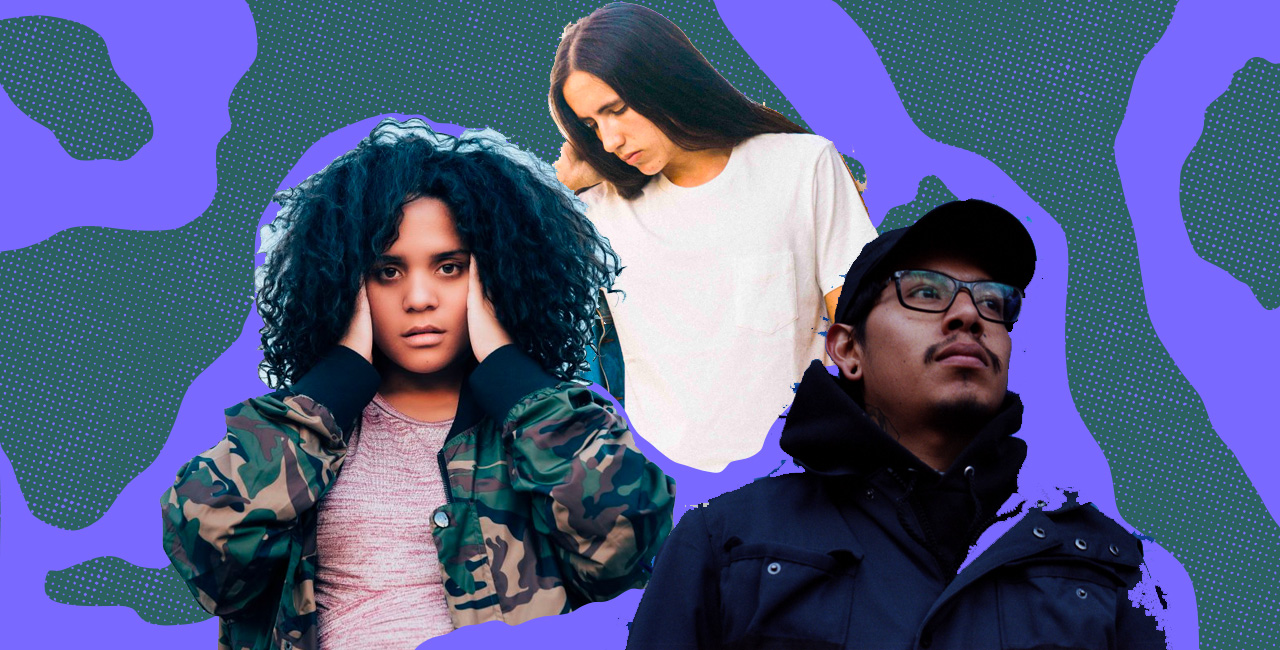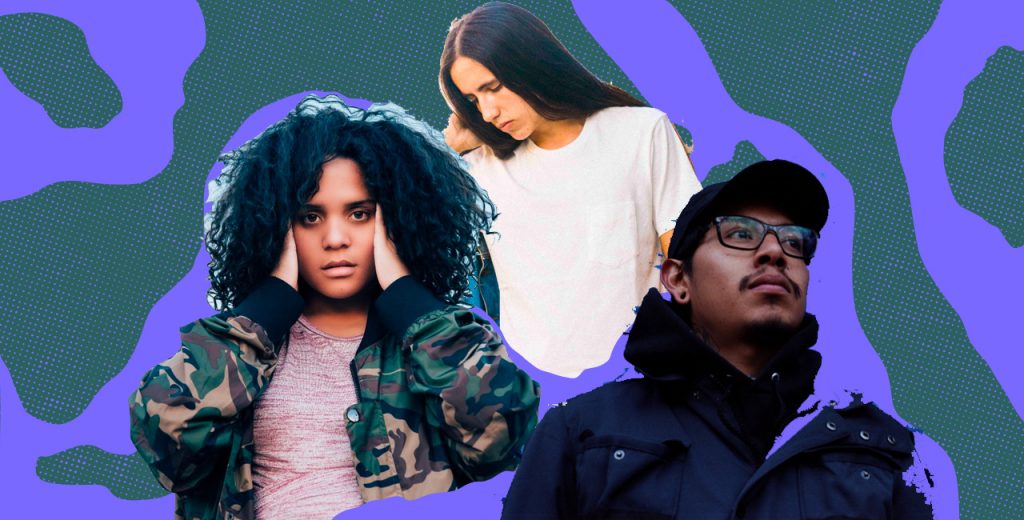More and more cities in the United States are choosing not to celebrate Columbus Day. Instead, a growing number of institutions are adopting Indigenous Peoples Day as a way to honor native communities in the Americas and remember the colonial genocide that ensued after Christopher Columbus’ arrival in 1492.
We’re celebrating Indigenous People’s Day by highlighting emerging Latin American and Latinx artists of indigenous descent. Pioneers like Luzmila Carpio in Bolivia and Ana Tijoux in Chile have paved the way for many of these younger artists, who are reinventing their musical traditions through a contemporary lens. But there need to be many, many more in the spotlight, so they can tell their own stories and ensure their contributions aren’t forgotten.
Some of the people on this list use their music for self-discovery through traditional sounds; others use them as a means to fight for their communities and their rights. Others still center race as a part of their identity to communicate a broader message; others just want to make you dance. It goes without saying, but “indigenous” is not a genre – these artists are are musically diverse, tearing down preconceptions with their work, while also reminding us that colonialism didn’t end with independence. Its dark history lives on.
Check out these talented artists, and sound off in the comments with your favorite artists who don’t appear here.
1
Mala Fama (Ecuador)
Producer Esteban Farinango (aka Mala Fama) comes from one of the many indigenous families that has migrated to Ibarra, Ecuador. Growing up in the city exposed him to all kinds of music, and he fell in love with rock and metal, playing in bands in his youth. But in his search for a sense of self through music, he stumbled upon artist and activist Jesús Bonilla, who introduced him to the traditional music of his own Kichwa community in Cotacachi.
Anta, his debut EP on Riobamba’s imprint Apocalipsis, is a tasteful and experimental interpretation of these sounds, where he incorporates elements from wawa wañuy (funeral chants for deceased children), Semana Santa flutes, recorded prayers, and interviews with elders. With this EP, Mala Fama is giving back to the community by donating part of its proceeds to Waruntzy, a non-profit organization dedicated to preserving and researching the indigenous music of Imbabura.
Mala Fama is currently working on new music, including collaborations with other indigenous Ecuadorian artists like singers Yurak Pacha and Taki Amaru.
2
Ishishcha (Peru)
From Cuzco, Peru, Jorge Vargas Prado found a way to connect to his indigenous roots and fight colonialism through language. The artist known as Ishishcha learned his grandmother’s native language of Quechua in college when he studied literature and linguistics, and made it the main language of his musical and literary work.
Ishishcha’s goal is to revolutionize the traditions embedded in his craft. He embraces sonic exploration and uses recorded instruments, electronic music programming, and field recordings as building blocks for his playful compositions. His lyrics are not only sung in Quechua; they’re also poems that tackle questions of sexuality and queerness.
He has called his latest release, the offbeat and light-hearted Guaf! I! Guaf! I! Healing seven!, his final album, but we’re crossing our fingers for more.
3
Renata Flores (Peru)
In 2015, people from all over the world turned their attention to Ayacucho singer Renata Flores, who joined the ranks of young YouTube stars when her take on Michael Jackson’s hit “The Way You Make Me Feel” went viral. But it wasn’t just a regular cover; with her grandmother’s help, she translated the lyrics to Quechua as a way to embrace her heritage and advocate for the kids who were bullied at her school for speaking the language, which has long been stereotypically associated with poverty.
Her YouTube fame and appearance in the Peruvian version of The Voice Kids sparked her career, and the 17-year-old is now a fully-fledged pop, R&B, and hip-hop artist. Her songs are slick, emotional, and still sung in Quechua. Her lyrics are also political; “Tijeras,” a song that blends trap beats and the traditional Andean danza de las tijeras, is a cry against femicide, a rising problem in Peru.
4
Pobvio (Uruguay)
Along with fellow Uruguayan producer Lechuga Zafiro, Pobvio co-founded Salviatek, the club music collective and label in 2014. Pobvio often looks to his Charrúa ancestors and their music to find inspiration and pay tribute to their traditions.
Felipe Lobato disrupts how identity is supposed to translate into club music, creating bass-heavy productions that borrow from local sounds but embrace universality. His remix of Lechuga Zafiro’s “Tambor Espada” is probably the most direct and intentional reference to Charrúa culture – specifically, the music from the Chaco province in northern Argentina. This rework warps the track’s original percussive elements until they resemble drum beats associated with the pampas, or lowlands, and adds siku pan pipe melodies.
Pobvio frequently includes pre-Columbian music in his DJ sets, and has participated in Día de la Nación Charrúa y la Identidad Indígena commemorations in Uruguay.
5
Lido Pimienta (Colombia)
Colombia-born, Canada-based interdisciplinary artist Lido Pimienta has become one of the most important creators of her generation, thanks to her shapeshifting electronic pop productions. Lido uses her voice as a powerful and moving instrument, highlighting the struggles of oppressed peoples in her songs, her explosive live shows, and on social media.
Her own Afro-indigenous roots have informed her approach to activism for years; Pimienta’s maternal relatives are Wayuu people, a group native to the desert region of La Guajira in northern Colombia, and she’s demonstrated a longtime commitment to highlighting the issue of water access in the community.
At the beginning of this year, she visited La Guajira to reconnect with her Wayuu family members, as documented in a video by CBC. There, she got to record music with an indigenous choir and vallenato musicians for Miss Colombia, the long-awaited follow up to La Papessa, her 2017 Polaris Prize-winning album.
She has collaborated with other artists of indigenous descent in Canada, like hip-hop giants A Tribe Called Red, Björk collaborator Tanya Tagaq, and Anishinaabe musician Melody McKiver.
6
Xiuhtezcatl (US/Mexico)
Born in Boulder, Colorado, 18-year-old Mexica activist and hip-hop artist Xiuhtezcatl Martínez has already made a splash worldwide. Xiuhtezcatl has long supported indigenous and environmental rights and climate change, and he has been involved in social initiatives since he was as young as six years old – his mother is the Executive Director of conservation organization Earth Guardians, and his father raised him and his siblings in the Mexica tradition. So far, he has spread his message via TED Talks, The Tonight Show, and the UN General Assembly, and he also rallied for the Standing Rock movement.
Xiuhtezcatl also addresses these topics through his own hip-hop songs, like his recently released debut full-length Break Free. Though it is mostly in English, Martinez sometimes switches between Spanish and Nahuatl, as he masterfully surfs over dark, cinematic beats to raise awareness about the difficulties indigenous communities like his face.
7
Mare Advertencia Lírika (Mexico)
After cutting her teeth in the graffiti scene in her hometown of Oaxaca, Mare Advertencia Lírika found her place as an empowered woman on the mic over 15 years ago. She’s chosen hip-hop as her weapon of choice – the vehicle she uses to amplify her commitment to social justice. The self-described feminist rapper is Zapoteca, one of the main indigenous groups in the Oaxaca Valley, the second poorest state in Mexico. So if there’s someone fit to rally for women’s and indigenous rights, and against racism and social inequity, it’s her.
Following her stint in Advertencia Lírika, Oaxaca’s only all-woman rap group to date, Mare went on to release multiple solo albums. 2016’s Siempre Viva is her latest, where she takes no prisoners over old-school hip-hop beats, splashed with funk and cumbia. She also works directly with marginalized communities, giving workshops and lectures to women and youth, using her platform to make an impact and create change.
8
Portavoz & Luanko (Chile)
Portavoz and Luanko are two Chilean rappers of Mapuche descent who have supported their community’s struggles to defend their ancestral land rights and to keep their culture alive. Together with DJ Cidtronyck, they released “Witrapaiñ” (which roughly translates to “We’re on Our Feet”), rapping in both Spanish and Mapudungun, the original Mapuche language, to further support their cause.
For Luanko, the ultimate goal is to keep Mapudungun alive by offering young Mapuches music that speaks to them and also uplifts their roots. Portavoz broadens his lyrical palette by also rapping about deep-rooted socioeconomic issues. Late last year, the Archbishop of Santiago invited the popular rapper to write a song to celebrate Pope Francis’ visit to the city, which he declined, citing the Catholic Church’s history of indigenous genocide all over the world. “Give back the land,” he wrote in his email reply.




